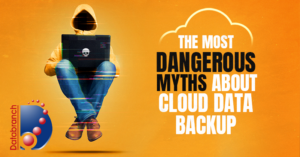
For businesses, Software-as-a-Service (SaaS) solutions offer unparalleled opportunities to enhance efficiency, scalability and overall operations. However, growing SaaS backup-related misconceptions also have the potential to hurt your business growth.
In this blog, we’ll shed light on some SaaS-related truths you simply cannot afford to ignore. Let’s dive in.
Don’t let these Myths put your Business at Risk
As businesses move to the cloud, here are some common misconceptions that need to be dispelled:
Myth 1: My SaaS solution is completely secure.
While leading SaaS solutions like Office 365, G Suite and Salesforce do offer top-of-the-line security along with robust recovery features, the truth is that they aren’t completely foolproof against all threats. They can’t protect your business data from malicious insiders, accidental deletions or hackers.
Solution: By regularly backing up your cloud data, you can protect it against a wide range of threats and unforeseen disasters.
Myth 2: My SaaS provider is solely responsible for my data security.
There is a widely held misconception that your SaaS provider is solely responsible for protecting your cloud data. The truth, however, is more nuanced. While a provider is expected to implement robust security to protect your data, businesses also are expected to play an active role.
Solution: Proactive steps like training your employees on data security best practices and implementing access control steps can ensure your data remains secure in the cloud.
Myth 3: My SaaS provider’s backup is all I need.
While some of the top SaaS providers offer features such as Recycle Bins and Vaults that can store accidentally deleted files, these solutions have limitations and don’t offer comprehensive backup and recovery.
Solution: Consider taking the help of Databranch. Our team of IT experts can not only help to securely back up your data but also help you enhance your cloud security.
Elevate your data security with a strategic partnership
Ready to empower your business with an advanced backup and recovery strategy? Contact Databranch today and let us help you build a comprehensive SaaS backup and recovery strategy that suits your business needs.
Let data recovery be the last of your worries! Contact us today for a free consultation and learn how our IT team can be your strategic partner. You can also download our free infographic today to learn more about the Shared Responsibility Model.
A Visual Guide to the Shared Responsibility Model
Although Software-as-a-Service (SaaS) applications are great for business, your cloud data is vulnerable and needs extra protection. The shared responsibility model clarifies how security responsibilities are divided between you and SaaS providers.








